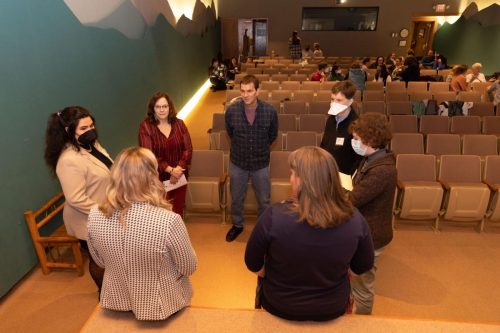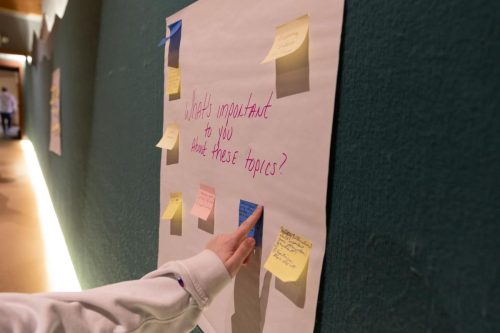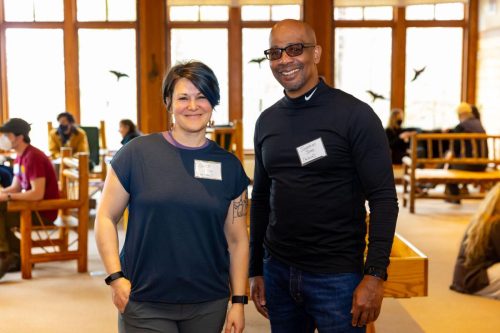“How are you feeling?”
It’s such a seemingly simple question — yet research by professor, lecturer and author Brené Brown has revealed that the average American adult has the ability to name only three feelings. How many can you name? Can you guess what they are? Maybe take a moment before reading further and see how many you can actually write down.
For most it is limited to these:
– Mad
– Glad
– Sad
That’s it — and I think we all know that human beings are vastly more complex than this.
Psychoanalyst Karl Jung once quipped that the paradox is the only thing complicated enough to approach being able to explain the human experience. Yet the average American adult is limited to naming three emotions. Perhaps this is why we greet each other with that dreaded platitude of “how are you doing?” with no reasonable expectation of a real response from the other party other than “ok” so we can move along to our next task for the day.
In April of this year, the Adirondack Diversity Initiative, with sponsorship from Paul Smith’s College, and support from North Country Community College and Citizen Advocates — hosted a 2-day intensive workshop on NonViolent Communication (NVC). We were privileged to have amazing trainers from the M.K. Gandhi Institute for Nonviolence— Gwen Olton and Jonathon Jones — teach us, and nearly 60 people join in the learning that took place at the VIC.
So what is NonViolent Communication? 
Quite simply, NVC is rooted in the idea that all human behavior is geared toward getting our needs met. We may not always be aware of what a specific need is, and our strategies for getting our needs met may not always work in our favor or be implemented with nonviolence. But as humans who are trying our best, we are all seeking ways to meet our needs.
It has been said by the neurobiologist Antonio Demasio that “we are not thinking machines. We are feeling machines that think.” We have named our species — homo sapiens — rather arrogantly perhaps, after our ability to think, and we like to think of ourselves as thinking machines. Yet the more we learn about our minds and bodies, the more it reveals that what actually defines us is our incredible capacity for feeling, with the occasional capacity to think rationally.
What NonViolent Communication seeks to teach us —as a technology, an application of learning — is how to better meet our human needs, without resorting to manipulation or violence. But we can only achieve this if we are in tune with our feeling selves.
Step 1: Name your feeling
The first step of NVC is reflecting on my more specific emotional state and then naming that feeling. In our training, we were aided with worksheets that pointed to over 180 emotions. For example, consider the difference between saying to my partner that “I felt angry (mad) that you didn’t communicate with me that you were going to be late” versus “I felt frustrated/puzzled/irritated/anxious/suspicious that you didn’t communicate with me that you were going to be late.” Depending on which feeling I pick in the second sentence, I would communicate a very different state of being and help to create a space for a very different conversation.
What is the actual feeling I’m trying to communicate? Is it in fact mad? Or is it something else? Angry and anxious are not the same.
Step 2: Identify the need behind the feeling 
Behind the feelings, we then begin to address the needs that are often driving our feelings. For example, to take the classic “dirty dishes” fight that so many roommates or partners get into — what is actually driving this? Perhaps one person’s need is to be more carefree, to enjoy downtime differently, and they don’t care about the dishes as a priority. That isn’t a need for them. Whereas for the other person, they need a tranquil and calm space — so for them having a messy kitchen is an infringement on that and feels like the other person then doesn’t care about their needs. If my need for tranquility and my partner’s need to be more carefree are in conflict – but we are making assumptions about one another’s behavior — then the likelihood of us ending up in a fight because we are assuming the other person doesn’t value us is rather high.
And this is just over something as superficial as dirty dishes, never mind something more value-based or political that is driving so much of the polarization in America right now.
Step 3: Make request to address your feeling and need
Making requests of someone else is the last step in NonViolent Communication, and it is a tricky step. A request is just that, and it can be met with a no. If we make a request we have to enter it knowing we may be rebuffed and told no. Part of learning to make requests is setting healthy boundaries, and learning what our needs are, and how to get those needs met, and how to negotiate more openly and transparently to do so.
However it is impossible to do this before we spend a great deal of time going through the (often exhausting) spectrum of human emotions and learning to better reflect upon our own state of being and to more correctly name what we are feeling. As we learn to do this, we can also better empathize with others.
When I realize that it isn’t just sadness I’m feeling when a friend took their life this past year (sad), but also feelings such as heavy, shocked, dejected, gloomy, or helpless, I can begin to reflect on the situation more fully. When two of my best friends since childhood, whom I’ve now known for some 40 years both lose their fathers during Covid, being more in touch with my own feelings like this around death, allows me to be a better friend to them in their own time of mourning — to move beyond just “sad” and to have a better ability to empathize with them. Not because I know what it is like for them —I don’t. But by living in a more full spectrum of the human emotional experience, we also are able to sit with others when they are engaged with that as well, instead of limiting them to mad, glad, or sad. How often have we perhaps caught ourselves saying to a friend “that must have made you angry/sad?” I know I have. Perhaps after learning NonViolent Communication, we can do better than that. Instead stay curious, and offer a deeper listening and say, “say more” or “what else?”
Learning and practicing 
Looking outside my window, at the mess our culture finds itself in, I certainly for one think we all could afford to spend some more time attuning ourselves to such wisdom and find ways to be more gentle and kind with ourselves and one another.
Many wonder what the link is between the interpersonal, dirty dishes, and say creating a more welcoming business, or attending to economic development, or being a more effective advocate for marginalized voices, being a better ally?
The one person we control in this world is ourselves. And if we are not in tune with our own emotional world, we can not be an effective force for good. Kingian nonviolence (the activist movement named after Martin Luther King) has many of its roots in Nonviolent Communication). We must start with the self, and extend from there to the interpersonal.
We can use a basketball analogy: if we aspire to play in the NBA, we better first learn how to dribble a basketball, and play in grade school and college. If we can not practice centering our emotional world and being in tune with oneself, or partner, friends, and colleagues, then the idea that we can do this when we find ourselves in a culturally, racially, or politically heated situation is absurd. Those are high stakes situations and require training.
Just like we couldn’t suddenly expect ourselves to compete with a professional athlete if we never go to a gym or train our bodies. We have to train our nervous and emotional systems as well.
There are many roads that lead to this, and content knowledge is certainly part of this — learning our histories in a more decolonized way, cultural consciousness training, all of these are pieces of a puzzle. So too is learning more about our own inner emotional worlds, and for that we need technologies like Nonviolent Communication to build a more peaceful and joyful world that is welcoming for all people.
Are you ready to create a space of welcoming and belonging in your workplace? Please join ADI and ANCA CPR staff for an FREE workshop and entry-point exploration of different methodologies — including nonviolent communication — and learn how to better articulate feelings, needs, requests, and boundaries in the workplace:
Building Welcoming & Belonging in the Workplace, Monday, September 19, 9 a.m. to 12 p.m. at Dewey Mountain Recreation Center, Saranac Lake, NY
Do you have questions about NVC or interest in participating in future opportunities to explore these concepts? Contact me at [email protected].
All photos by Katie Kearney from Communicating for Change Summit: A facilitators training on nonviolent communication on April 22-23, 2022 at Paul Smith’s College.
Bottom photo: Gwen Olton and Jonathon Jones of the M.K. Gandhi Institute for Nonviolence

